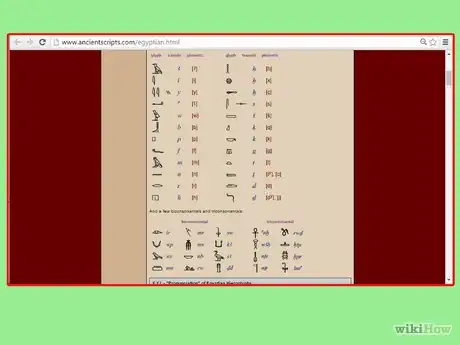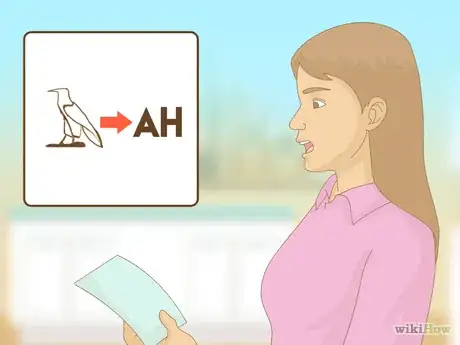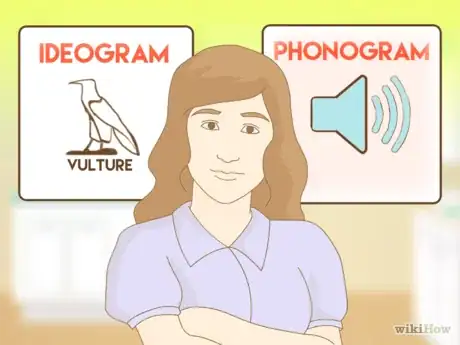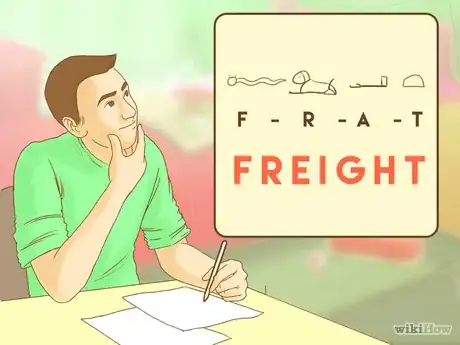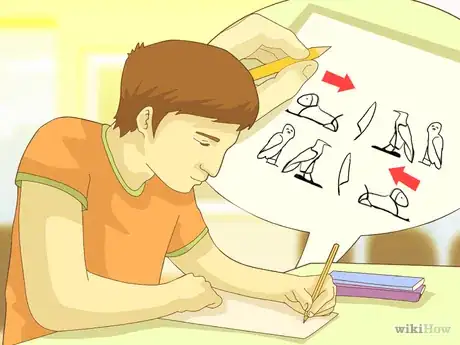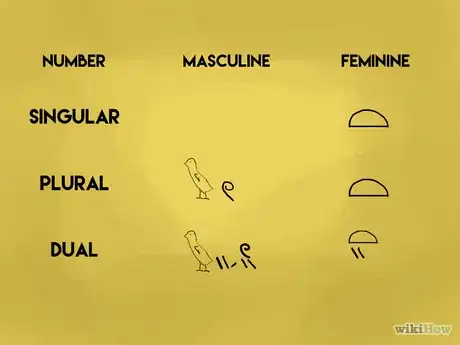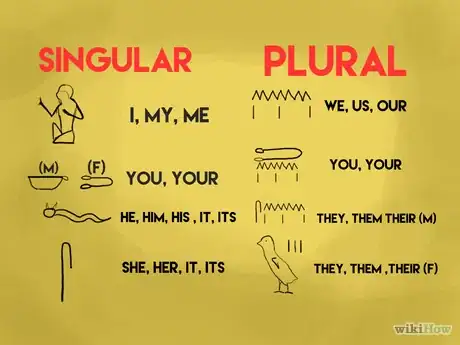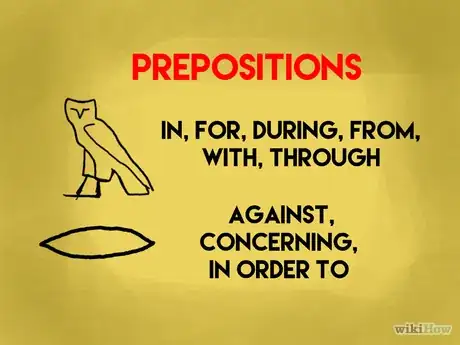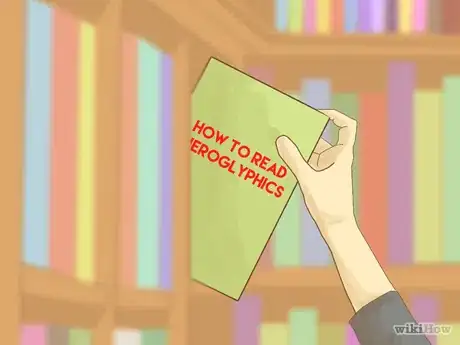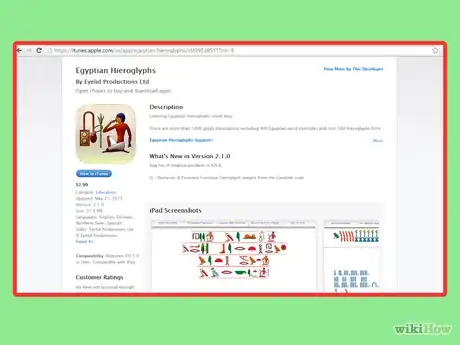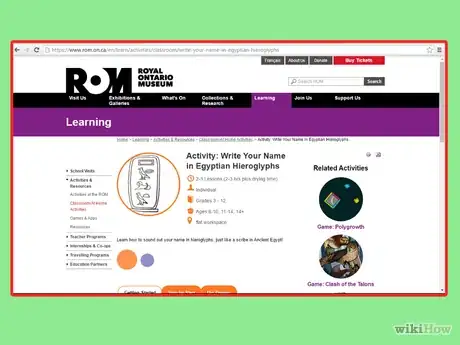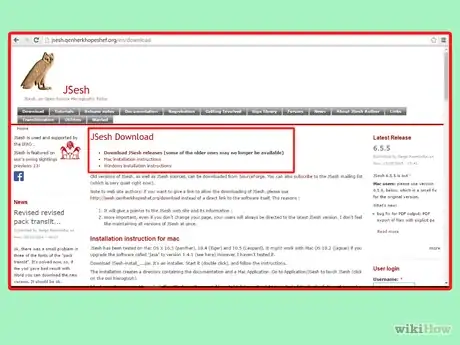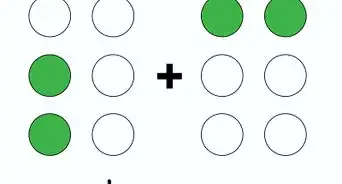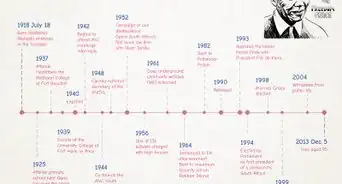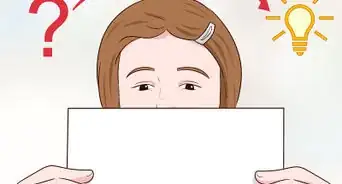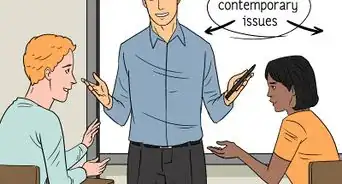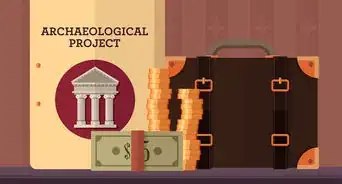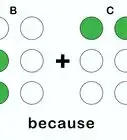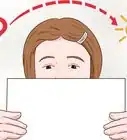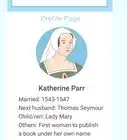This article was co-authored by wikiHow Staff. Our trained team of editors and researchers validate articles for accuracy and comprehensiveness. wikiHow's Content Management Team carefully monitors the work from our editorial staff to ensure that each article is backed by trusted research and meets our high quality standards.
There are 13 references cited in this article, which can be found at the bottom of the page.
wikiHow marks an article as reader-approved once it receives enough positive feedback. In this case, several readers have written to tell us that this article was helpful to them, earning it our reader-approved status.
This article has been viewed 243,330 times.
Learn more...
Hieroglyphs were developed by the ancient Egyptians as a way to integrate writing into their artwork. Rather than letters, like we see in modern English, ancient Egyptians used symbols. These symbols, or hieroglyphs (or glyphs for short), can have more than one meaning depending on how they are written. The steps below will help you understand the basics of Egyptian hieroglyphs and can be used as a starting place for further education on the subject.
Steps
Learning the Ancient Egyptian Alphabet
-
1Obtain a visual chart of the Egyptian hieroglyphic alphabet. Because hieroglyphics are images and not letters, like we use in modern English, it’s quite difficult to describe how to read them if you can't visually see them. Start your learning process by obtaining a visual alphabet chart from the internet. Print the chart out and keep it with you while you learn.[1]
- The following list of URLs all offer visual charts of the Egyptian hieroglyphs translated into the English alphabet:
- The glyphs found in these alphabet charts are also referred to as ‘unilateral’ because most have only one symbol.
-
2Learn how to pronounce the hieroglyphs. Even though some glyphs can be translated into a letter from the English alphabet, they don’t all sound exactly the same as the English letter. The URL where you obtained the glyph alphabet should also contain a chart that shows what each glyph’s pronunciation sounds like. Print this chart off as well and keep it with you as reference.[2]
- For example, the bird-like hieroglyph translates to what looks like a three, ‘3,’ but is pronounced as ‘ah.’
- Technically speaking, the pronunciations are a guess from Egyptologists. Since the Egyptian hieroglyphs are a dead language, there is no one around to demonstrate how the sounds are pronounced. Instead, Egyptologists had to make educated guesses based on a later form of the Egyptian language called Coptic.
Advertisement -
3Learn the difference between an ideogram and a phonogram. Egyptian hieroglyphics have two main types: ideograms and phonograms. Ideograms were drawings that directly represented the object being written about. Phonograms were drawings that represented sounds. Since the Ancient Egyptians didn’t write vowels, phonograms mostly represent consonant sounds.[3]
- Phonograms can represent one sound or multiple sounds. Refer to the glyph alphabet you downloaded for specific examples.
- Ideograms, in addition to having a literal translation (e.g. a glyph that’s a pair of legs might mean movement or walking), may also have a not-so-literal translation (e.g. the same leg glyph combined with other glyphs might actually refer to giving directions).
- Egyptian hieroglyphs were normally created with phonograms at the start of a word and ideograms at the end of a word. In this case, the hieroglyph is also referred to as a determinative.
-
4Create your own sentences with hieroglyphs. Hieroglyphs represent sounds, not letters. As such, there are no glyphs that are silent like there are letters in the English language that are silent. In order to spell a word using hieroglyphs, you need to be sure each sound in the word is represented by a glyph.[4]
- For example, the word ‘freight’ is spelled using seven letters, but only contains four sounds. The sounds are ‘f,’ ‘r,’ ‘long a,’ and ’t.’ Therefore, in order to spell the word freight using hieroglyphs, you need to use the glyphs for each of the four sounds. In this case it would be the horned viper plus a lion laying down plus an arm plus a bread loaf.
- Not all sounds that are found in the English language have an associated sound (and therefore glyph) in ancient Egyptian.
- Because a lot of vowels are silent in the English language, they aren’t used when spelling a word in ancient Egyptian. This means it can be hard to decipher what word is being spelled because there could be more than one possible translation. This is where determinatives come in. Use a determinative glyph after spelling a word in hieroglyphic in order to help describe the word properly.
Reading Ancient Egyptian Hieroglyphs
-
1Determine in which direction hieroglyphs should be read. Hieroglyphs can actually be read in almost any direction: left to right, right to left, and top to bottom. To determine how to read a specific set of glyphs, start by locating a glyph with a head. If the head is facing to the left, start reading from the left and work you way towards the head. If the head is facing the right, start reading from the right and work you way towards the head.[5]
- If the glyphs appear in vertical columns, always start at the top and work your way down. However, you still need to determine if you read right to left or left to right.
- Note that some glyphs may be grouped together to save space. Tall glyphs are usually drawn on their own while short glyphs may be stacked on top of one another. This means one line of hieroglyphs may require you to read both horizontally and vertically.
-
2Deciphering ancient Egyptian hieroglyphic nouns. Hieroglyphs have two types of nouns, gender nouns (masculine vs. feminine) and quantity nouns (singular, plural, or dual).[6]
- In most, but not all cases, when a noun is followed by the bread loaf glyph it indicates that the word is feminine. If the noun doesn’t have a bread loaf glyph, it is likely masculine.
- A noun that is plural may be represented by either the quail chick glyph or the rope curl glyph. For example, the glyph containing water and a man means ‘brother' (singular). The same glyph with a quail chick included means ‘brothers.'
- A noun that is dual may be represented by two backwards slashes. For example, the glyph containing water, a rope curl, two backwards slashes, and two men means ‘the two brothers.'
- Sometimes dual and plural nouns do not contain these extra glyphs, instead vertical lines or multiple glyphs of the same type will indicate how many of those items are being referred to.
-
3Learn ancient Egyptian hieroglyphic suffix pronouns. A pronoun is a substitute for a noun and is normally used after the noun (also known as the antecedent) is first used. For example, in the sentence “Bob tripped as he climbed the stairs,” ‘Bob’ is the noun and ‘he’ is the pronoun. In ancient Egyptian pronouns also exist, but may not always follow an antecedent.[7]
- Suffix pronouns must be attached to nouns, verbs, or prepositions, they are not individual words. They are the most common pronouns in ancient Egyptian.
- My, me, and I is represented by either a person glyph or a reed leaf glyph.
- You and your is represented by basket with handle glyph when it is referring to a masculine singular noun. And is represented by a bread loaf glyph or tethering rope glyph when it is referring to a singular feminine noun.
- He, his, it, and its is represented by a horned viper glyph when it is referring to a masculine singular noun. And is is represented by a folded cloth glyph when it is referring to a singular feminine noun.
- Our, us, and we are represented by the water glyph on top of three vertical lines.
- Your and you (the plural versions) are represented by either the bread loaf glyph or the tethering rope glyph on top of the water glyph and three vertical lines.
- Their, them, and they are represented by a folded cloth glyph or a door bolt glyph plus the water glyph and three vertical lines.
-
4Grasp the idea of ancient Egyptian hieroglyphic prepositions. Prepositions are words like under, beside, on top, near, between, until, etc. that make other words in a sentence make sense in terms of time and space. For example, in the sentence “the cat was under the table,” the word ‘under’ is the preposition.[8]
- The owl glyph is one of the most versatile prepositions in ancient Egyptian. Most of the time it translates to ‘in’ but can also mean ‘for, during, from, with, and through.'
- The mouth glyph is another versatile preposition that can mean ‘against, concerning, and in order to,’ depending on the context of the sentence where its contained.
- Prepositions can also be combined with nouns to make a compound preposition.
-
5Understand ancient Egyptian hieroglyphic adjectives. Adjectives are words that describe nouns. For example, in the sentence “the pink umbrella,” the word ‘pink’ is the adjective as it is describing the noun ‘umbrella.’ In ancient Egyptian, adjectives can be used as both modifiers of nouns and as nouns themselves.[9]
- Adjectives that are used as modifiers will always follow the noun, pronoun, or noun phrase they modify. These types of adjectives will also have the same gender and plurality as the noun.
- Adjectives that are used as nouns have the same rules as nouns in terms of feminine versus masculine and singular versus plural versus dual.
Getting Help Learning Egyptian Hieroglyphic
-
1Buy a book on how to read hieroglyphic. One of the most recommended books that can teach you to read Egyptian hieroglyphic is How to Read Egyptian Hieroglyphs: A Step-by-Step Guide to Teach Yourself by Mark Collier and Bill Manley. The most recent version was published in 2003 and is available at a variety of online booksellers.
- If you go to any online bookseller (e.g. Amazon, Book Depository, etc.) and search for “Egyptian Hieroglyphs” you’ll be presented with a large number of options.
- Read through the reviews on a bookseller’s website or on Goodreads to determine which book may meet your specific needs.
- Make sure the book can be returned, or try to get a look inside the book before you buy it, just in case it isn’t what you wanted.
-
2Download an iPhone / iPad app. The Apple Store has a number of Egyptian-related apps that can be downloaded to either an iPhone or an iPad. One specific app, called Egyptian Hieroglyphs, was designed specifically to help teach the user how to read glyphs. The same developer also has an app that can turn a QWERTY keyboard into an Egyptian hieroglyphs keyboard.[10]
- Most of these are paid apps, but the costs are fairly low.
- Keep in mind that these apps will have a decent variety of glyphs to learn from, but will not be complete.
-
3Follow the Royal Ontario Museum’s activity website. The ROM’s website (https://www.rom.on.ca/en/learn/activities/classroom/write-your-name-in-egyptian-hieroglyphs) contains step-by-step instructions on how to write your name in Egyptian hieroglyphs. The website contains all the info required to complete this simple task, but doesn’t go into detail about more complicated hieroglyphs.
- The ROM also has an extensive Ancient Egyptian gallery with a number of artifacts on display. It may be worth the visit (if you’re in the area) in order to get an idea of what actual hieroglyphs looked like when carved into stone and other materials.
-
4Install the JSesh editor on your computer. JSesh is an open source ancient Egyptian hieroglyphic editor that is free to download from the program’s website at http://jsesh.qenherkhopeshef.org.
- The website also contains complete documentation and tutorials on how to use the software.
- Technically, JSesh is designed for people who already know something about hieroglyphics, but can still be a useful tool while you’re learning or if you want to challenge yourself.
-
5Study Egyptology. There are many in-class and online courses available on topics related to Ancient Egypt and Egyptology. For example:
- The University of Cambridge’s has a workshop called Learn to read ancient Egyptian hieroglyphs. If you aren’t able to attend the course in-person, download the course syllabus in PDF format. The syllabus contains a number of other helpful resources that you may find useful.[11]
- Coursera has an online course called Ancient Egypt: A history in six objects, which is available for free for anyone who has internet access. While it doesn’t teach hieroglyphic specifically, it does talk about Ancient Egypt by using actual artifacts from the time period.
- The University of Manchester has both a certificate and diploma program in Egyptology, all available online. They also have courses available that can be taken on their own, for those who are interested. While the programs are online, the ability to go to specific museums and libraries may be useful.
Community Q&A
-
QuestionHow many characters are there in hieroglyphics?
 TomPNTop AnswererIn total, there are hundreds of hieroglyphics. They weren't all used at the same time, though. Initially, the Egyptians developed logograms, where a single glyph stands for a whole word. Later on, they realized they also needed glyphs for individual letters, but they couldn't get rid of the earlier glyphs since hieroglyphics were sacred (hieroglyphics actually comes from a pair of greek words meaning "words of the gods")
TomPNTop AnswererIn total, there are hundreds of hieroglyphics. They weren't all used at the same time, though. Initially, the Egyptians developed logograms, where a single glyph stands for a whole word. Later on, they realized they also needed glyphs for individual letters, but they couldn't get rid of the earlier glyphs since hieroglyphics were sacred (hieroglyphics actually comes from a pair of greek words meaning "words of the gods") -
QuestionHow did the Egyptians read hieroglyphics?
 TomPNTop AnswererWith great difficulty. Most Egyptian couldn't read hieroglyphs. Those that could formed the scribe class. Because of the difficulty of reading hieroglyphs, scribes were very well renowned (they were the equivalent of the upper class today).
TomPNTop AnswererWith great difficulty. Most Egyptian couldn't read hieroglyphs. Those that could formed the scribe class. Because of the difficulty of reading hieroglyphs, scribes were very well renowned (they were the equivalent of the upper class today). -
QuestionWhat is hieroglyphics?
 IdabelleCommunity AnswerHieroglyphics are the written language that the ancient Egyptians used. Instead of letters, this language was written using symbols.
IdabelleCommunity AnswerHieroglyphics are the written language that the ancient Egyptians used. Instead of letters, this language was written using symbols.
Warnings
- Most ancient Egyptian hieroglyphic alphabets found online include only a subset of possible glyphs available. In order to get a full list of all possibly glyphs (which number in the thousands) you may need to obtain a book that specializes in ancient Egyptian hieroglyphs.⧼thumbs_response⧽
- Learning to read ancient Egyptian hieroglyphic will not be a quick and easy task. Those who study Egyptology can spend years learning how to read hieroglyphs properly. Not to mention that entire books have been written to teach people how to read hieroglyphs. This article outlines the basics, but is not a complete and total representation of everything there is to learn about Egyptian hieroglyphs.⧼thumbs_response⧽
References
- ↑ https://www.egyptabout.com/2016/12/hieroglyphics-chart.html
- ↑ https://www.friesian.com/egypt.htm
- ↑ https://ancientegyptonline.co.uk/hieroglyphs-tutorial/
- ↑ http://www.virtual-egypt.com/newhtml/hieroglyphics/
- ↑ https://www.glasgowlife.org.uk/media/6526/translating-hieroglyphs.pdf
- ↑ https://ancientegyptonline.co.uk/hieroglyphs-tutorial2/
- ↑ https://ancientegyptonline.co.uk/hieroglyphs-pronouns/
- ↑ http://www.egyptianhieroglyphs.net/egyptian-hieroglyphs/lesson-4/
- ↑ http://www.egyptianhieroglyphs.net/egyptian-hieroglyphs/lesson-5/
About This Article
A good starting point for learning the Egyptian hieroglyphic script is to memorize the alphabetic or uniliteral signs. These are phonograms, or sound signs, that represent single sounds, like the folded cloth for “s” or the leg and foot for “b." From there, you can move on to learning signs that represent groups of 2 or more sounds. Other signs in the hieroglyphic script, called ideograms, represent ideas or words rather than sounds. For example, a man with his hand to his mouth is often used in words related to speaking, eating, or thinking. Once you learn the most common ideograms, focus on learning how they work together in groups with phonograms to build words. For more tips, including how to read singular and plural nouns in Egyptian hieroglyphics, read on!
